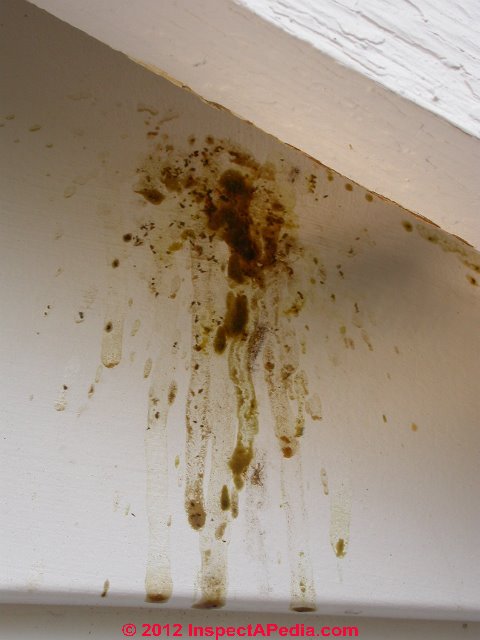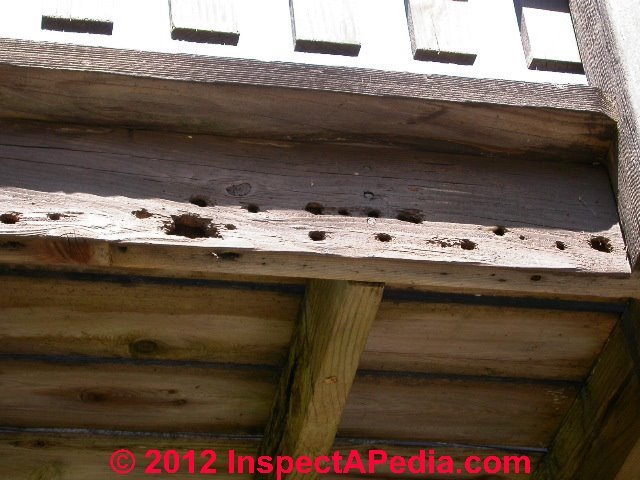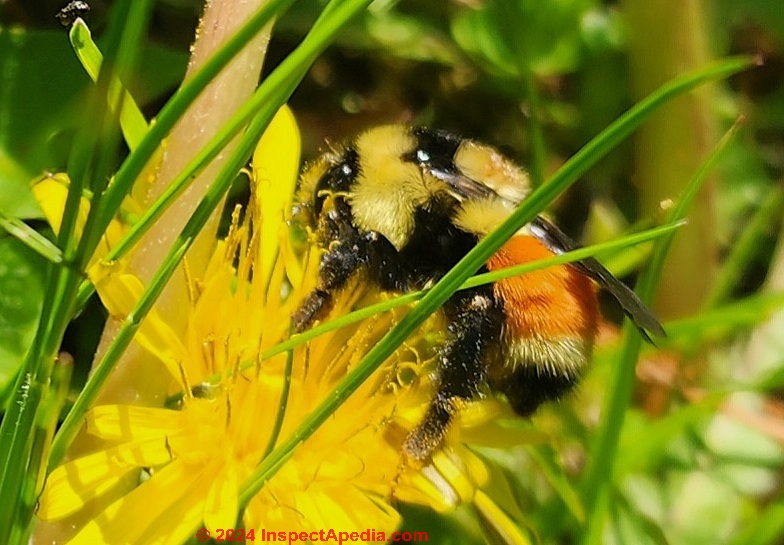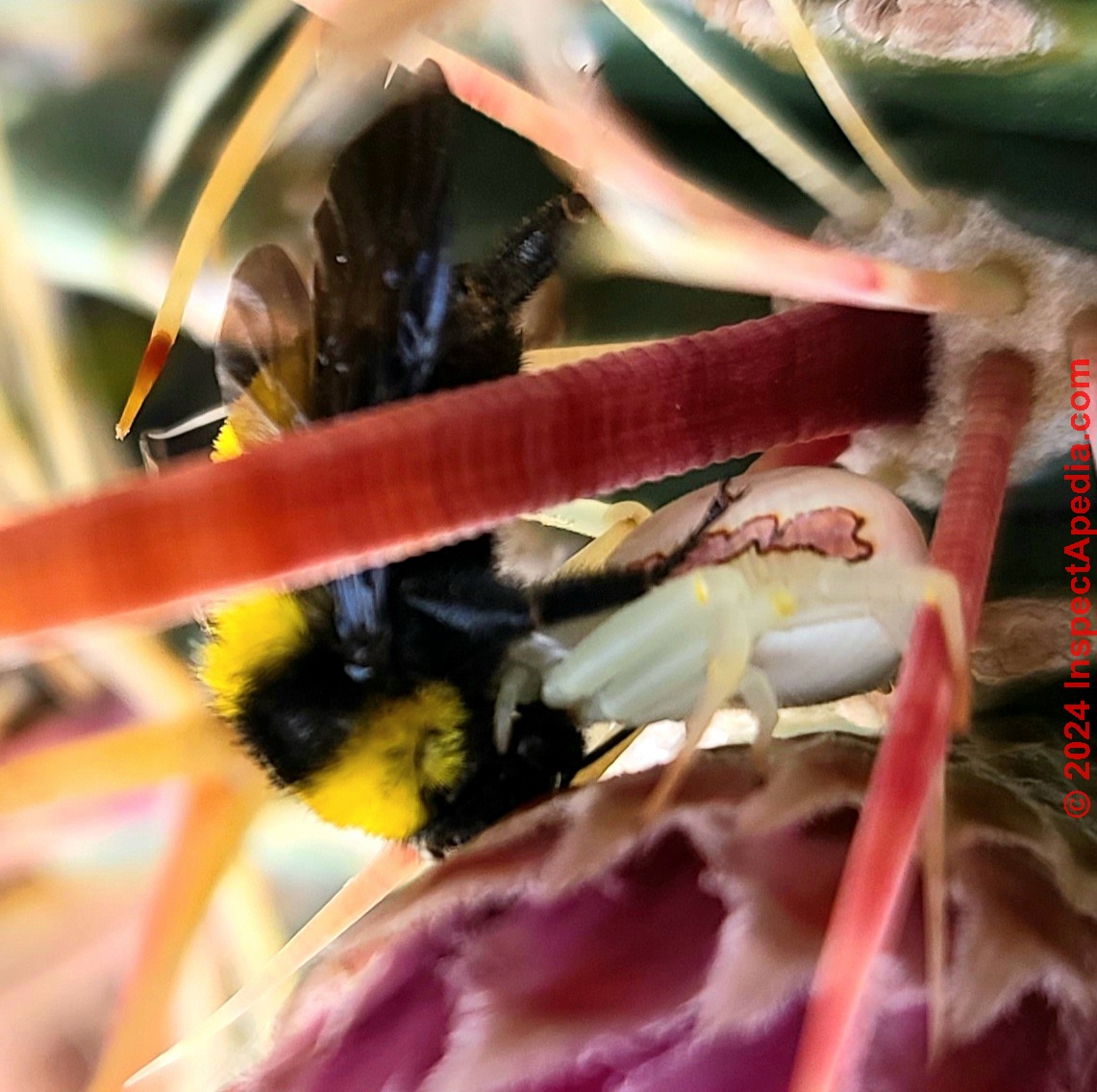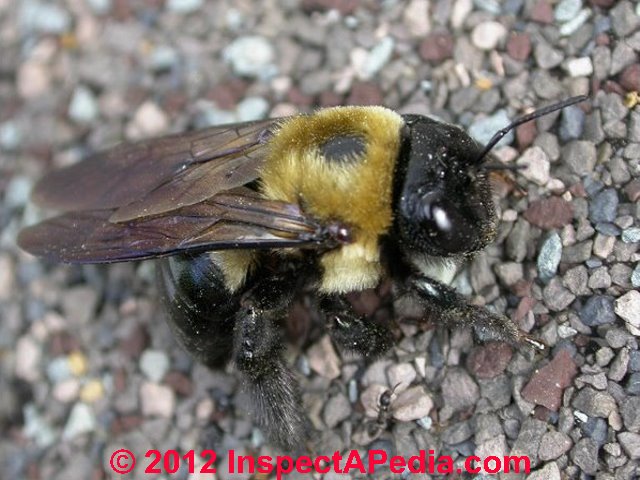 Carpenter Bees
Carpenter Bees
How to identify carpenter bees,
inspect for bee activity,
bee damage prevention & cure
- POST a QUESTION or COMMENT about carpenter bees: what they look like, how to find carpenter bee damage, how to get rid of carpenter bees, how to prevent carpenter bee infestations
Carpenter bee infestation guide for buildings:
This article describes carpenter bees (Xylocopa spp. - about 500 species) and how to inspect a building for carpenter bee damage.
We explain and illustrate how to identify carpenter bees - what carpenter bees look like, why and where they attack buildings, and how to cure a carpenter bee infestation using pesticides or other methods.
We describe building details that increase the risk of carpenter bee infestation - which tells you where to look for damage as well as how to prevent carpenter bee infestations in buildings without reliance on pesticides.
We also describe how to distinguish carpenter bees from other insect or other types of building damage and how to tell a carpenter bee from other insects. We include examples of building damage caused by carpenter bees. And we provide citations to authoritative sources for more carpenter bee identification & control information.
Page top photo: a carpenter bee found crawling around on our roof.
InspectAPedia tolerates no conflicts of interest. We have no relationship with advertisers, products, or services discussed at this website.
- Daniel Friedman, Publisher/Editor/Author - See WHO ARE WE?
Carpenter Bees Guide: what they look like, how to find carpenter bee damage, how to get rid of carpenter bees, how to prevent carpenter bee infestations
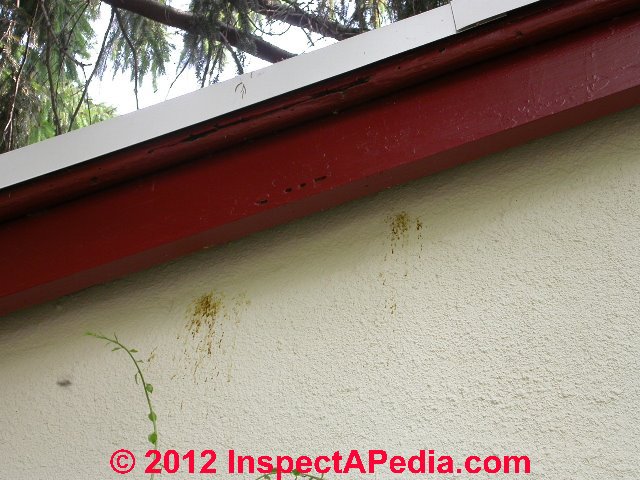 Carpenter Bees, (Xylocopa proxylocopa), like the handsome carpenter bee shown at the top of this page, nest by burrowing into hard woody material such as dead trees and in suburban areas into the edges or occasionally surfaces of wood on buildings, typically wood trim but occasionally structural members too.
Carpenter Bees, (Xylocopa proxylocopa), like the handsome carpenter bee shown at the top of this page, nest by burrowing into hard woody material such as dead trees and in suburban areas into the edges or occasionally surfaces of wood on buildings, typically wood trim but occasionally structural members too.
Usually these insects are solitary in their nest construction and foraging but you may see multiple carpenter been nests near one another, and in some cases female Xylocopa proxylocopa are reported to share or even divvy up the work of foraging, nesting, nest laying, and nest defense.
Photo: carpenter bee entry holes in a building soffit and bee "splash marks" left by bees entering the structure. These marks may be the easiest carpenter bee clue to spot. Below we also illustrate the coarse "sawdust" frass left by active carpenter bees.
While their damage and occasional actual destruction of wood trim leads building owners to treat carpenter bees as a pest, considering the worldwide decimation of bees of many genera/species, in our OPINION treatment of carpenter bee pests at buildings ought to be performed with some thought.
Article Contents
Early Signs of Carpenter Bee Activity on a Building
Often the first evidence you may see of carpenter bee activity will be a perfectly round hole about 5/16" in diameter in the edge of exterior trim boards at a soffit or fascia (photos further below on this page).
But two very good clues of carpenter bee activity at a building are only slightly more subtle: carpenter bee tracking marks on building siding or walls just below wood trim (photo above) or a neat little pile of fresh sawdust beneath a hole where a carpenter be is busy tearing away at a wooden trim board (photo below).
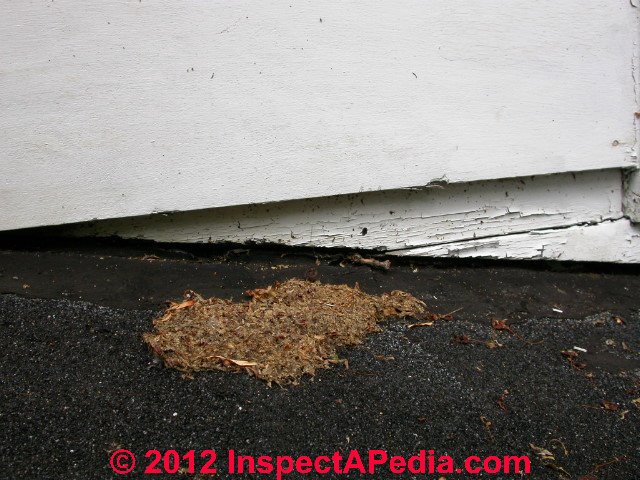
Look for tracking, sawdust, exit holes, or the insects themselves. But look first for these splashes on building siding that may indicate carpenter bee activity (page top photo).
Two more examples of these bee marks are shown just above and below.
Carpenter Bee Entry & Exit Holes in Building Wood Trim or Wooden Structural Members
 Those 5/16" to 1/2" perfectly round holes carpenter bees cut into (usually) the edges of wood trim or other exposed lumber are made by the female carpenter bee to prepare a nest, typically six to ten inches deep into the wood.
Those 5/16" to 1/2" perfectly round holes carpenter bees cut into (usually) the edges of wood trim or other exposed lumber are made by the female carpenter bee to prepare a nest, typically six to ten inches deep into the wood.
When carpenter bee damage holes appear in the face of a trim board more often they are oblate, as shown in photo at left.
In these nicely drilled openings into building wood trim or even deck or porch framing, the female carpenter bee deposits eggs that hatch into larvae and develop into young adult carpenter bees, feeding initially on pollen stored in the nest by the parents.
Because carpenter bees like to return to the same nest each year, the length or depth of these nests can become much larger, extending many feet along the interior of wood trim or other boards on building exteriors.
Watch out: Because the holes made by carpenter bees (for purposes of nesting and laying eggs) are so perfectly round and because often you see only those openings they can be mistaken for drill marks
. Don't confuse insect damage or holes such as those made by carpenter bees or powder post beetles with mechanically made drill holes in wood boards, beams, or other structural components on or in buildings.
At DRILL MARKS we show drill marks in wood caused by an amateur pest treatment attempt.
While to an experienced eye, holes in wood caused by insects are easily distinguished from those caused by humans using a drill or hammer and nail, on occasion someone is fooled.
Below in our photographs of carpenter bee damage to two different buildings we illustrate two cases of holes that are caused by insects, not mechanical events on buildings: powder post beetle holes in wood, and carpenter bee holes in wood.
Both of these examples of carpenter bee damage are old - weather and decay have softened the edges of carpenter bee openings and exits in the wood.
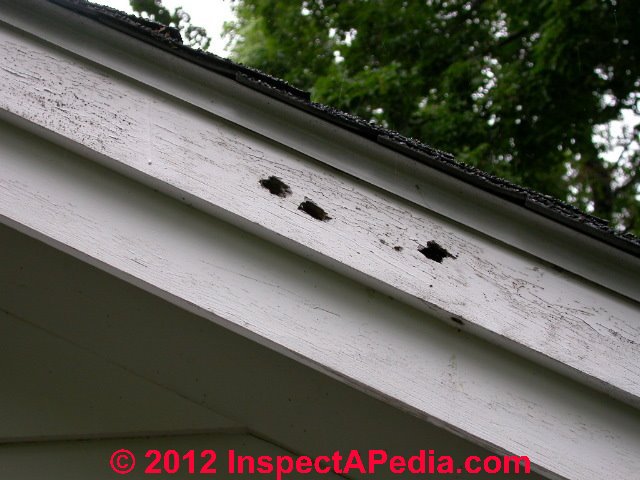
What to Do About Carpenter Bees: 4 options: kill vs. seal vs. replace wood vs. vacuuming?
Unlike more serious wood destroying insects such as CARPENTER ANTS or TERMITES, carpenter bees are solitary insects, so using the term "infestation" to describe carpenter bee activity on a building can be a bit over-stated.
Nonetheless, as our deck photograph above shows, left unattended these bees can eventually cause extensive damage to a building or to a wooden deck or more often its wood trim.
Unlike carpenter ants and termites, carpenter bees do not invade deeply into a structure - their activity is usually found on external trim and exposed wood structural members such as the deck above.
But you can also see that this deck has been severely damaged.
 Photo: this carpenter bee was crawling about on the rooftop on a cool morning and was quite willing to pose for a photo - Ed.
Photo: this carpenter bee was crawling about on the rooftop on a cool morning and was quite willing to pose for a photo - Ed.
- Avoid killing carpenter bees (or any other bees) if at all possible:
Certainly don't kill a carpenter bee out of fear of being stung. Female carpenter bees (shown at left) are capable of stinging but are not aggressive. Male carpenter bees have no stinger.
We don't like to kill carpenter bees unnecessarily as they are solitary insects and as they are important pollinators for some (open faced) flowers.[4] But where an individual is causing a lot of trouble, a quick squirt of insect killer spray into an active carpenter bee-drilled opening is usually enough to send the bee elsewhere (or kill it if it's inside the opening at the time).
Where killing carpenter bees becomes necessary because of an extensive colony and significant building damage, dry insecticide powder blown into nest openings can kill hatching larvae as will an (easier to use) spray insecticide with residual effects.
Use a sprayer with a plastic straw-type nozzle that can be inserted right into the carpenter bee nest opening. (Don't spray insecticide in your own face during this operation.)
The University of California Integrated Pest Management Program also recommends using a desiccant dust (diatomaceous earth or boric acid), inserting it into the nest openings.[8]
The dust kills the developing insects by a combination of abrasion and drying out. However desiccant dusts remain effective only if the dust stays dry - which may be optimistic when this approach is used on exterior trim openings, especially shallow ones, located in climates subjected to wind-blown rain.
See this BORIC ACID MSDS (Fisher Scientific 2014) - Fill carpenter bee nest holes, seal surfaces:
Because carpenter bees like to return to the same nest each year, when the holes are empty, try making the nesting site less attractive by filling existing holes with caulk or hard wood putty, and keep the surfaces of exposed wood coated with paint or a preservative stain. - Replace badly damaged wood:
For trim boards that have been extensively damaged (making filling holes inappropriate) we replace the board with preservative treated lumber, making sure to follow the manufacturer's directions for also treating and sealing cut ends of the wood.
In our OPINION, advice of some experts to use hardwood for all exterior repairs is simply not practical - people do not pay for oak boards for soffits and fascias.[8] - Vacuuming out carpenter bees? we have read at least one source who recommends vacuuming out the carpenter bee nest to attempt to remove any bees or larvae - an idea which may sound ecologically sound but in our OPINION is a bit iffy: imagine dragging your shop vac up a fifteen foot ladder and then, in mid-air, trying to suck bees out of a 5/16" to 1/2" hole in the edge of a board.
And what happens to people standing on a ladder, holding a vacuum cleaner, when the bees get mad?
Other Large Black & Yellow Bees Mistake for Carpenter Bees
Our photo above shows a Tricoloured Bumble Bee or Orange-belted bumbleee (Bobmus ternarius) photographed in Two Harbors Minnesota in May, 2024. This useful pollenator may be mistaken for a Carpenter bee but it's not.
Below, a Mexican Bumblebee trapped and being eaten (sucked dry) by a white spider (visible under the bee's head), caught while collecting pollen from a cactus, photographed in San Miguel de Allende, Guanajuato, Mexico in January 2024.
Research on Carpenter Bee Damage & Control
- [3] Hahn, Jeffrey, Colleen Cannon, and Mark Ascerno, "Carpenter Ants", University of Minnesota Extension, retrieved 9/19/2012, original source: http://www.extension.umn.edu/distribution/housingandclothing/dk1015.html, copy on file as [Carpenter_Ants_UMinn.pdf]
- [5] Jones, Susan. "Fact Sheet Carpenter Bees". Ohio State University Extension, retrieved 9/22/12, original source http://ohioline.osu.edu/hyg-fact/2000/2074.html
- [6] Minckley, R.L. 1998. A cladistic analysis and classification of the subgenera and genera of the large carpenter bees, tribe Xylocopini (Hymenoptera: Apidae). Scientific Papers, Natural History Museum, University of Kansas 9:1–47. Archive.org. Retrieved 09/22/2012, original source http://www.archive.org/details/cladisticanalysi00minc
- [7] "U.C. Riverside Entomology Research Museum: "Carpenter Bees" Order Hymenoptera Family Apidae, genus Xylocopa". Entmuseum.ucr.edu. Retrieved 9/22/12, original source: http://entmuseum.ucr.edu/bug_spotlight/posted Images-pages/34.htm
- [8] "Pest Notes: Carpenter Bees", University of California Statewide Integrated Pest Management Program, UC ANR Publication 7417 retrieved 9/22/12, original source: http://www.ipm.ucdavis.edu/PMG/PESTNOTES/pn7417.html [copy on file as Carpenter_Bees_UCIPM.pdf]
- Waldvogel, Michael, Patricia Alder, "Carpenter Bees Biting and Stinging Pests" NC State Extension, Entomology and Plant Pathology (July 2018) retrieved 2019/11/05, original source: https://content.ces.ncsu.edu/carpenter-bees
Excerpts:The carpenter bee is so-called because of its habit of excavating tunnels in wood with its strong jaws. The round half-inch diameter entrance holes (Figure 2) are usually found on the underside of a board.
A tell-tale trace of coarse sawdust is often found on the surface beneath the hole. Wooden decks, overhangs and other exposed wood on houses are prime targets. Painted and treated woods ... are less preferred, but they are by no means immune to attack.Unpainted or stained cedar, cypress and redwood shingles and siding are also attacked despite their pest-resistant reputations. Carpenter bees, like their distant relatives, the carpenter ants, differ from termites in that they do not eat wood as food. They simply excavate tunnels for nesting sites.
- See additional citations at REFERENCES at the end of this page
...
Reader Comments, Questions & Answers About The Article Above
Below you will find questions and answers previously posted on this page at its page bottom reader comment box.
Reader Q&A - also see RECOMMENDED ARTICLES & FAQs
 Field report & photo: carpenter bees attacked our polyurethane foam exterior trim
Field report & photo: carpenter bees attacked our polyurethane foam exterior trim
2019/10/24 Carpenter bee are attacking the polyurethane column caps on my front entrance. I have treated for the bees but I am still debating patch them holes with foam , sand, and paint, Vs replace the column cap. Do you have advice?
This discussion was posted originally
Reply: early report of carpenter bee attack on plastic or polyurethane exterior trim
Grace:
That's impressive carpenter bee damage and the first time I've seen them into polyurethane. To be absolutely sure we're really seeing bee damage to plastic-covered polyurethane trim (in this case a column capital) t I'd like to see a closeup or perhaps a probe of the material - are you sure it's not MDF a wood fiber product?
The trim above your column capital looks like an AZEK®PVC type product. Indeed polyurethane exterior trim details such as column caps that you show are in increasingly wide use.
Seeing carpenter bee attack on polyurethane trim is a new phenomenon in my experience and just a little surprising.
Woodpeckers? On buildings that I've inspected I have occasionally seen woodpeckers rapping in the carpenter bee nest area and even ripping open the carpenter bee nest to go after the carpenter bee larvae. So is it possible that in addition to carpenter bees boring into your polyurethane column capital [Photo above] you also had some woodpecker activity in the same area?
Certainly that larger notch in the capital around the right side of the image in your photo is more likely to be woodpecker damage. [Post additional photos if you can, one per comment, on this page.]
Some inventors claim that polyurethane trim is carpenter-bee resistant. E.g.
- Ettinger, Richard. "Polyurethane foam building members for residential and/or commercial buildings." U.S. Patent Application 14/946,402, filed May 19, 2016.
Excerpt: ... such as moisture (eg, can be mold resistant) and/or can be resistant to termite, carpenter ant, carpenter bee, - Sawyer, Kenneth I., and Robert J. Kupper. "Borer-Resistant Wood, Wood Products, and Wooden Structures and Methods." U.S. Patent Application 12/496,188, filed October 22, 2009.
Above this reader Q&A section we include more research on carpenter bees, carpenter bee damage & carpenter bee control.
A bit of care in what we are calling this material in your photo is particularly important as if it's really polyurethane (a foam product) then that's important and new information.
Below are examples of a polyurethane based exterior trim column capital and crown mouldings.
 You will want to consult the installation, maintenance and repair instructions for the specific manufacturer and brand of your polyurethane exterior trim components. Here is an example:
You will want to consult the installation, maintenance and repair instructions for the specific manufacturer and brand of your polyurethane exterior trim components. Here is an example:
- AZEK, AZEK TRIM & MOULDING INSTALL GUIDE [PDF] AZEK®Building Products, 1330 W Fulton Street Suite #350,Chicago, IL 60607 USA, including AZEK composite building products such as Timbertech decking and railing, pavers, and trim and moulding AZEK Trimboards Websites: www.azek.com Tel: 877 275 2935 Retrieved 2019/11/04, original source: https://azekexteriors.com/docs/installation/azek_trimmoulding_install_guide.pdf?sfvrsn=4b586f58_28
Note: Our reference here to AZEK® as an illustration of polyurethane-based trim and decorative building products is for example only. We have no data to suggest that the carpenter bee attack on the exterior polyurethane column capital shown above was on an AZEK product. - Editor.
At TRIM, EXTERIOR CHOICES, INSTALLATION we discuss polyurethane trim on building exteriors and cite various sources, manufacturers, products.
specifically at POLYMER MOLDING TRIM & building DETAILS and also
and at CELLULAR PVC TRIM MOLDINGS
and at DEFINITIONS, ENGINEERED WOOD HDF LDF LVL MDF MDO OSB we and describe define MDF and similar products.
A comparison of MDF trim and polyurethane trim is found at TRIM, INTERIOR INSTALLATION
So do take a close look and do confirm what material is in your photo.
I agree that the diameter of the holes looks consistent with carpenter bees, and I speculate that if this is a foam trim then it's soft enough that a bee might also have made the crater surrounding the hole, but it's beyond my experience; Because the diameter of the damage around the hole is so large, even though that may be due to softness of the polyurethane foam, I must ask if there is there any chance this is woodpecker damage. (Probably not). Have you seen bees going in and out of these holes?
For a couple of small holes from carpenter bee damage it's possible to patch using an exterior sealant such as polyurethane or even phenolic caulk but that damage looks rather large; When I've sealed smaller openings the bees went elsewhere; I do not like to just plug holes if there are bees inside - I want them to be away from home first; some pest control folks use an approved insecticide spray in the holes before sealing them;
Thank you for this important report.
One can but wonder: maybe, because we're killing off trees and using less wood and more plastic, carpenter bees have evolved to learn to chew through the thin plastic skin and then dig easily through poly foam filled trim components.
On 2016-06-19 by (mod) carpenter bees don't bore through metal
Chris, carpenter bees won't bore through metal. I have had success covering an area of carpenter bee damage that was about 12" in length by tacking up metal flashing and painting it to match the trim. But of course as you pose, the bees might choose to return later and simply bore new tunnels nearby.
On 2016-06-19 by chris
Will these bees make their holes in tin soffits? If I fill or cover holes will they just make more holes around the covered hole. My soffits are 22 feet high and I would not like to spray above my head, that high. Thanks
On 2013-02-25 by (mod) will anyone take away my carpenter bees?
MJ: a licensed pest control company may come to kill off your bees (which IMO is a shame) but no, these are not swarming bees, they work as solitary carpenters, so it's not practical to expect to solve a carpenter bee problem by catching and relocating a "bee swarm".
On 2013-02-25 by MJ
Will beekeepers come and get these bees? I saw a bee (not sure what kind)going into an opening under our bow window last fall. I found a hole in the concrete block foundation that we were unaware of. My husband said not to block them in for the winter because they might get in the house somehow.
Thanks
...
Continue reading at TERMITE DAMAGE PROBING or select a topic from the closely-related articles below, or see the complete ARTICLE INDEX.
Or see these
Recommended Articles
- HONEY BEES in BUILDING WALLS
- INSECTS & FOAM INSULATION - carpenter ants in foam board insulation
- INSECT DAMAGE PREVENTION
- INSECT INFESTATION / DAMAGE - home
- POLYSTYRENE FOAM INSULATION
- STRUCTURAL DAMAGE PROBING
Suggested citation for this web page
CARPENTER BEES at InspectApedia.com - online encyclopedia of building & environmental inspection, testing, diagnosis, repair, & problem prevention advice.
Or see this
INDEX to RELATED ARTICLES: ARTICLE INDEX to INSECT DAMAGE
Or use the SEARCH BOX found below to Ask a Question or Search InspectApedia
Ask a Question or Search InspectApedia
Questions & answers or comments about about carpenter bees: what they look like, how to find carpenter bee damage, how to get rid of carpenter bees, how to prevent carpenter bee infestations.
Try the search box just below, or if you prefer, post a question or comment in the Comments box below and we will respond promptly.
Search the InspectApedia website
Note: appearance of your Comment below may be delayed: if your comment contains an image, photograph, web link, or text that looks to the software as if it might be a web link, your posting will appear after it has been approved by a moderator. Apologies for the delay.
Only one image can be added per comment but you can post as many comments, and therefore images, as you like.
You will not receive a notification when a response to your question has been posted.
Please bookmark this page to make it easy for you to check back for our response.
IF above you see "Comment Form is loading comments..." then COMMENT BOX - countable.ca / bawkbox.com IS NOT WORKING.
In any case you are welcome to send an email directly to us at InspectApedia.com at editor@inspectApedia.com
We'll reply to you directly. Please help us help you by noting, in your email, the URL of the InspectApedia page where you wanted to comment.
Citations & References
In addition to any citations in the article above, a full list is available on request.
- [4] Wikipedia Web: https://www.wikipedia.org/ provided background information about some topics discussed at this website provided this citation is also found in the same article along with a " retrieved on" date. NOTE: because Wikipedia entries are fluid and can be amended in real time, we cite the retrieval date of Wikipedia citations and we do not assert that the information found there is necessarily authoritative.
Carpenter Bees, retrieved 9/22/12, original source: http://en.wikipedia.org/wiki/Carpenter_bee
Following references 5-7 cited by above. - In addition to citations & references found in this article, see the research citations given at the end of the related articles found at our suggested
CONTINUE READING or RECOMMENDED ARTICLES.
- Carson, Dunlop & Associates Ltd., 120 Carlton Street Suite 407, Toronto ON M5A 4K2. Tel: (416) 964-9415 1-800-268-7070 Email: info@carsondunlop.com. Alan Carson is a past president of ASHI, the American Society of Home Inspectors.
Thanks to Alan Carson and Bob Dunlop, for permission for InspectAPedia to use text excerpts from The HOME REFERENCE BOOK - the Encyclopedia of Homes and to use illustrations from The ILLUSTRATED HOME .
Carson Dunlop Associates provides extensive home inspection education and report writing material. In gratitude we provide links to tsome Carson Dunlop Associates products and services.



